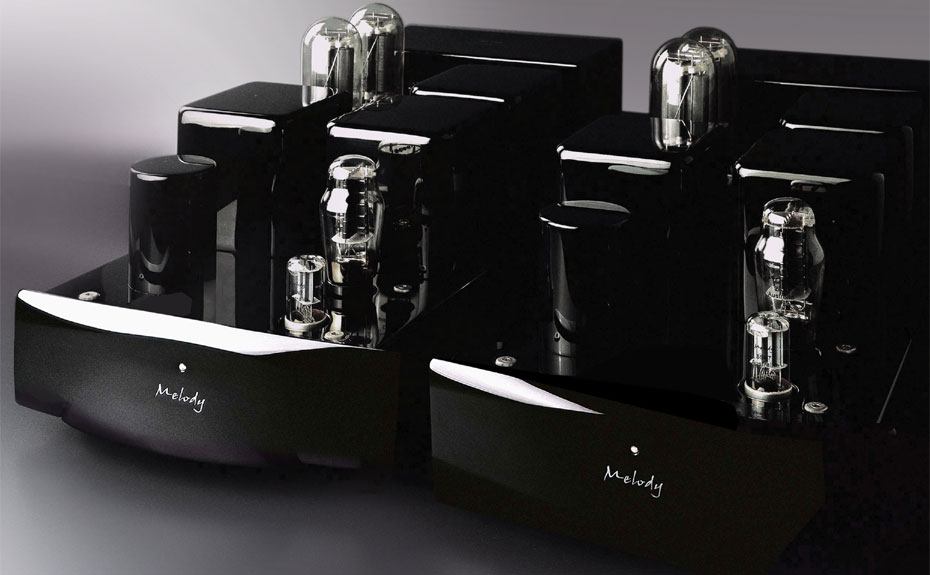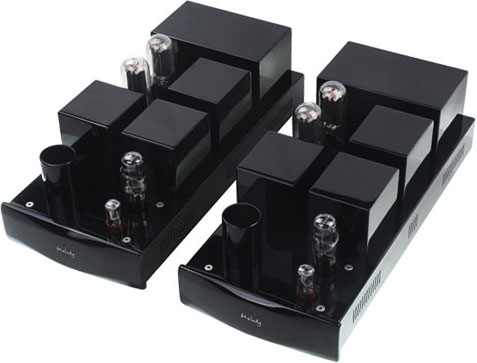What initially brought my attention to the Melody Valve electronics was the GR Research speakers being offered by Angel City Audio, who is the U.S. importer of Melody Valve. Later, I heard the combination of PM845 monoblock amplifiers, Pure Black 101 preamp and GR Research LS6 loudspeakers at Lone Star Audio Fest. I was very impressed by the results. There was smoothness, combined with drama and power, that I associated with much more expensive equipment. The gold standard for powerful single-ended amps has to be the Audio Note UK Gaku-On, though I’m sure others will have their favorites. In an all-Audio Note system, the Gaku-On’s had an almost perfect blend of 300B-like single-ended purity, with the power needed to play most types of music. Unfortunately, they are very expensive amps. With many expensive parts, quality magnetic materials, and silver wire, the big Audio Notes could never be a budget offering.
Other manufacturers have attempted to build powerful, yet affordable, single-ended amps. The problem is that almost all of them have a roughness and/or colored sound that lower-powered amps do not have. Some are decidedly poor sounding. The 211 and 845 output tubes, so popular because of their high plate dissipation, are tough to drive. Most of the cheap amps try to drive the output stage with barely capable circuits, populated by mediocre quality parts. The result is something that sounds no better than most push-pull pentodes, good quality transistors and other “normal” amps. One kind of distortion is traded for another kind. It’s moving deckchairs on the Titanic. While there are valid points when comparing analog to digital distortion, one being more unnatural than the other, trading moderate 3rd harmonic distortion for massive amounts of 2nd harmonic distortion (with lots of extra noise) is not an acceptable compromise. With audio, there are very few compromises that don’t sound compromised.
The challenges of high powered SEDHT – Comparing the 845 to the 300B
One of the reasons the 300B is such a great sounding tube is that its plate resistance (Rp) is relatively low. Actually, as a general statement, triodes are low impedance devices, and pentodes are high impedance devices. All things being equal, a triode-wired pentode, namely a pentode wired up to run as a faux triode, has lower Rp than the pentode wired version, the way the designer intended the tube to be used. Another general statement is that the higher the resistance, the more noise is generated, or picked up. These are really generalized statements. There are several reasons low impedance devices can be better than high impedance ones; this goes for cartridges, tubes, resistors, capacitors, etc., etc.. A complication caused by changing from one tube to another tube, besides blatantly obvious things like plate dissipation, which is the power a tube can produce, is that each tube will have a preferred load, based on its own Rp and the operation point chosen. The operation point will be the idle current, that is where the tube operates when it isn’t playing music, and plate voltage chosen to operate the tube. It’s like changing the carburetor and camshaft on a hotrod’s engine. Depending on the Rp, plate voltage, and idle current, you will be able to narrow down to a relatively small sweetspot, where the tube will produce both high output (in watts) and low distortion. If you move the operation point one direction you get higher output, but higher distortion, and vice versa. What this all means, for whatever reasons you choose, is that lower Rp tubes, like the 300B, are more revealing than higher Rp tubes.
So what about tubes like the 845, 211 and other “big” “RF” tubes? When you hear or read someone say an audio output tube was an “RF” tube, it means radio frequency, and it was usually designed for amateur radio use. The real “radio station tubes” are so dangerous that only a fool would try one for audio. If you think 1,000 volts is dangerous, try 5,000, or 10,000 volts. Some very high voltage tubes produce ionized radiation and dangerous levels of RF energy that can literally cook something if it’s too close. These higher power tubes produce more dissipation by running at higher voltages. All things being equal, the higher the voltage, the more watts being produced (or consumed). The 300B has a max plate dissipation of 40 watts, and max voltage of 450VDC; the 845 has a max plate dissipation of 100 watts and a max voltage of 1250VDC. The plate impedance of the 300B is rated at 700 ohms, and that of the 845 is 1,700 ohms. So, the tubes are designed to get higher power by running higher voltages, and a side effect is that the plate resistance goes up. My assumption is that if they did not increase plate resistance, excess current would destroy the tube. If the 300B and 845 were typical resistors, the 845 would have more than twice the noise.
As a consequence of the higher voltage and higher plate resistance needed to properly run the 845, the output transformer for an 845 needs a wider winding ratio to match the plate of the 845 to the speaker, when compared to a 300B. Very basically, this means that the 845 transformer has more copper winding on the primary than a 300B output transformer (more turns of wire to get the impedance high enough for the 845). The net result, all things being equal, is that the output transformer for a 845 will have more “copper losses” than a 300B transformer. More practically, this means that it’s easier for “Joe Blow Winder” to make a 300B transformer than an 845. The 845 transformer, besides having more copper losses, will have more capacitive coupling and leakage inductance, causing problems with high frequencies. Also, to get the same bass, but at higher power, the transformer core has to be larger. The greater the power, and the lower the frequency, the larger the core must be, all other things being equal.
The bottom line is this: Given any winder of transformers, their 300B transformer should measure, and sound better than their 845 transformer. However, there are ways to work around this problem. The easiest and most successful is to run more tubes in parallel. Just like paralleling two 10KOhm resistors to get 5KOhm, the same thing happens with vacuum tubes. Of course, there are complications that can arise from parallel tubes: They should be matched, have to be biased separately, can make life for the previous amplifier stage more difficult, etc..
Speaking of the previous stage: In the PM845, a 2a3 drives an interstage transformer, which then drives the output tubes. I have no idea about the winding ratio or core material, though a typical interstage/driver transformer offers a combination of gain, plus the ability to drive the output tube into class A2 territory, meaning it can supply some grid current, where a capacitor-coupled stage would simply run out of drive. So, this amp is designed to put out considerable power by virtue of using parallel 845s and driving them with a transformer.
- (Page 1 of 3)
- Next page →



